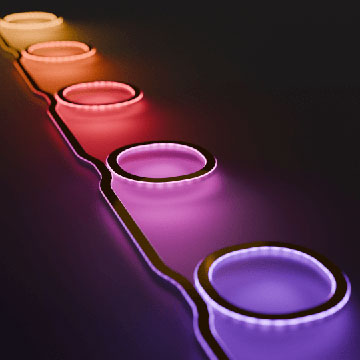
Artist’s conception of the new tunable ring laser. [Image: Joshua Mornhinweg]
Nearly 60 years has passed since tunable lasers were invented, but scientists still make tradeoffs between accurate tuning and a broad frequency range. Some of these devices require moving parts, which adds to their cost and complexity. Even tunable semiconductor lasers still force researchers to choose between narrow tuning ranges and unpredictable mode hops.
A team in the United States and Austria has devised a compact multiring semiconductor laser that can tune widely and smoothly (Optica, doi:10.1364/OPTICA.559884 ). Group members say that the chip-sized laser maintains the same output wavelength, without mode hops, even when injected with an input beam of 75 mW.
The ring architecture
The new device contains five ring-shaped quantum cascade lasers (QCLs), each with a different radius between 220 and 260 μm. The five QCLs are not perfect circles, though; each consists of four straight 50-μm sections connected by quarter-circles with varying radii. All rings are connected to the same waveguide.
Each of the rings lases at a distinct frequency and can be tuned over 10 cm–1 or 0.3 THz. The design of the laser ensures that only one wavelength is emitted at a time, which makes it easily scalable and stable across different environments. A combination of three of the rings, which can be operated independently, gives the device a tuning range greater than 33 cm–1 or roughly 1 THz without mode hops.
“By adjusting the size of the ring, we can effectively target any line we want and any lasing frequency we want,” said study author Theodore Letsou, Harvard University, USA. “All the light from every single laser gets coupled through the same waveguide and is formed into the same beam. This is quite powerful because we can extend the tuning range of typical semiconductor lasers, and we can target individual wavelengths using a different ring radius.”
Testing the laser
The researchers compared the ring laser’s 8-μm-wavelength output to that of a commercially available external-cavity QCL that can tune over a range of more than 200 cm–1 but suffers from mode hops. Likewise, a commercial distributed-feedback QCL can tune without mode hops, but only over a range of approximately 4 cm–1.
The team concluded that the main difference between its device and the commercially available lasers is the method of light emission.
They found that their laser was able to tune without mode hops and over a greater spectral range than the commercial one. The team concluded that the main difference between its device and the commercially available lasers is the method of light emission—while most compact ring QCLs are surface or substrate emitting, the team’s is facet-emitting. Their ring-array laser can also maintain a stable frequency output over time because of how it can be biased during continuous-wave operation; in contrast, other such lasers show frequency chirping during a pulsed bias.
The new device’s unidirectional mode of operation renders it less sensitive to optical feedback than other kinds of tunable semiconductor lasers, according to the scientists. The researchers hope that the ring-style laser geometry can be incorporated into other types of chip-scale devices such as interband cascade lasers and quantum dot lasers.
Leading the research team were Optica Fellow Federico Capasso of Harvard University, USA, and his frequent collaborator, Benedikt Schwarz of the Vienna University of Technology, Austria. Capasso is one of the coinventors of the QCL in 1994.

